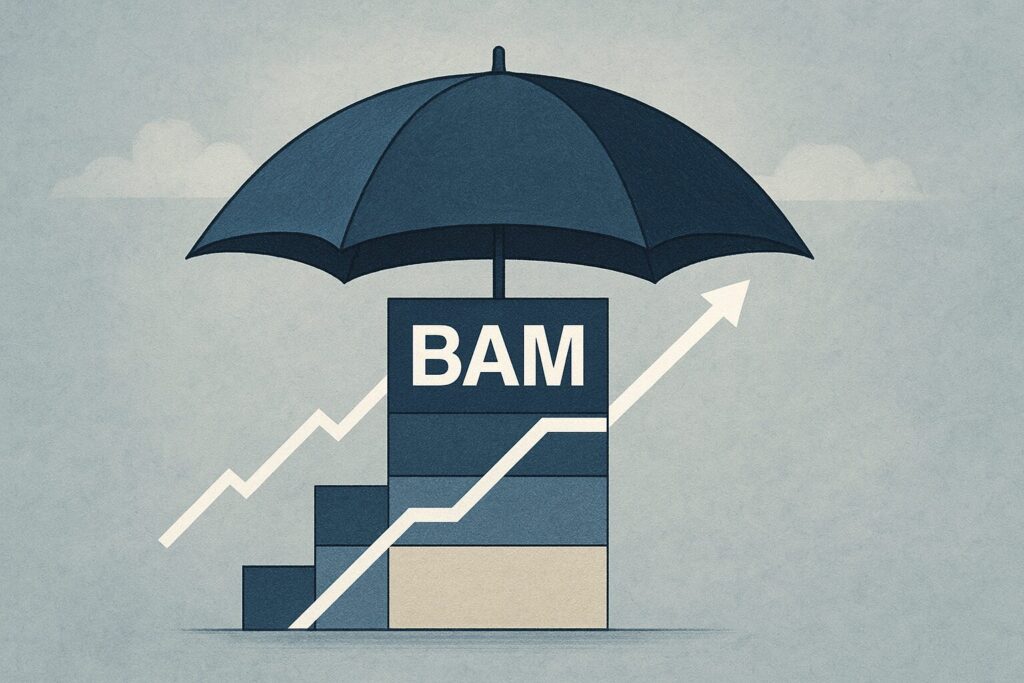
Why retirees can take comfort in Brookfield Asset Management’s strong track record during tough times
When markets crash, investors panic. But some companies stand firm—and even come out stronger. Brookfield Asset Management is one of them. For retirees looking for an investment that can weather economic storms and still deliver dependable income, Brookfield has a history worth examining closely.
This post explores how Brookfield has performed during the two biggest downturns of the past two decades—the 2008 financial crisis and the 2020 COVID crash—and why its unique approach makes it one of the safest and most reliable companies to own in retirement.
Brookfield’s Mindset: Conservative, Long-Term, and Opportunistic
Brookfield isn’t your typical asset manager. Instead of chasing hot stocks or high-risk growth, it invests in real assets like infrastructure, real estate, renewable energy, and private credit. These are long-lived, cash-generating assets backed by contracts and hard value—not just sentiment.
And unlike many Wall Street firms that push leverage and risk in good times, Brookfield’s leadership team is known for discipline, patience, and preparation. It’s no coincidence that during downturns, Brookfield is often one of the only major players with enough liquidity to buy while others are selling in desperation.
The 2008 Financial Crisis: Ready When Others Weren’t
The global financial crisis of 2008 sent shockwaves through the banking and investment world. Lehman Brothers collapsed. Big banks needed bailouts. Real estate tanked. But Brookfield didn’t just survive—it thrived.
Why? Because it had seen the warning signs early.
- Brookfield began building cash reserves as early as 2007.
- By the time the crisis hit full force, Brookfield had $6 billion in liquidity.
- While others scrambled, Brookfield went on a buying spree—acquiring distressed assets in real estate and infrastructure at bargain prices.
In the years following the crisis, those assets rebounded in value, generating outsized returns for Brookfield and its investors.
💡 Key takeaway: Brookfield didn’t need to guess the market bottom—it simply followed its long-term plan and was financially ready to act when the time came.
The 2020 COVID Crash: Calm in the Storm
In early 2020, global markets plunged as the COVID-19 pandemic caused widespread economic shutdowns. Investors dumped risk assets, and volatility exploded.
Brookfield’s stock price dipped along with the broader market—but behind the scenes, the company was once again prepared:
- It had over $15 billion in cash and credit lines ready to deploy.
- Another $46 billion in client capital was committed and available through its investment vehicles.
- Its core assets—toll roads, utilities, data centers, and long-term leased real estate—continued generating income despite the crisis.
Rather than pulling back, Brookfield went on offense. It invested in renewable energy infrastructure, real estate, and private credit opportunities that had suddenly become available at steep discounts.
As the world emerged from the worst of the pandemic, Brookfield’s strategy paid off once again. Its businesses rebounded, its dividend remained safe, and its value as a stable operator became even clearer.
Built to Withstand Volatility
Brookfield’s consistent performance in downturns isn’t a fluke. It’s the result of a business model designed from the ground up to handle uncertainty:
🔹 Real Assets
Brookfield invests in infrastructure, real estate, and renewable power—essential services that people and governments rely on, even in recessions.
🔹 Long-Term Contracts
Its assets are often backed by multi-decade contracts, meaning revenues are predictable, even when markets are turbulent.
🔹 Global Diversification
Brookfield operates in over 30 countries, spreading its risks across geographies and sectors.
🔹 Disciplined Management
Brookfield is famously cautious with debt and maintains ample liquidity. It prefers to buy when others are forced to sell.
🔹 Institutional Trust
Major pension funds, sovereign wealth funds, and governments invest with Brookfield. That vote of confidence adds a layer of safety for all investors.
A Closer Look at Brookfield During Crises
| Crisis | Brookfield Action | Outcome |
|---|---|---|
| 2008 Financial Crisis | Raised cash early, bought distressed assets | Strong recovery and expansion |
| 2020 COVID Crash | Maintained liquidity, invested in undervalued infrastructure and renewables | Dividend held steady, assets appreciated post-recovery |
These examples show that Brookfield doesn’t panic in downturns—it executes.
What This Means for Retirees
If you’re retired—or approaching retirement—the last thing you want is an investment that disappears when the market drops. Brookfield offers something different:
- Consistent dividends backed by real, cash-producing assets
- Lower volatility than most equities thanks to stable infrastructure and contracted income
- A leadership team with a proven crisis playbook
While no investment is risk-free, Brookfield has proven through multiple major downturns that it’s capable of preserving and growing capital in a way that aligns with the needs of retirees.
The Bottom Line
When the market crashes, Brookfield doesn’t flinch. It leans on its conservative strategy, diversified assets, and fortress-like balance sheet to not only survive—but emerge stronger. For retirees who need income and want peace of mind, Brookfield Asset Management stands out as one of the most resilient, time-tested choices available.
📘 This post is adapted from my book:
The Single Best Dividend Stock for Retirees: Retirement Income You Can Count On,
available now at Amazon.com in paperback and eBook formats.
Disclaimer: This content is for informational purposes only and should not be considered investment advice. Always consult a licensed financial advisor before making investment decisions. Past performance does not guarantee future results.